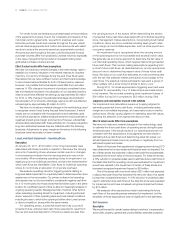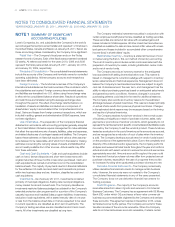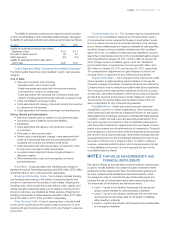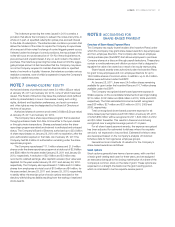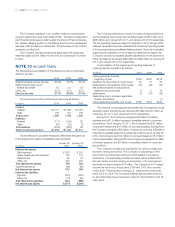Lowe's 2010 Annual Report Download - page 38
Download and view the complete annual report
Please find page 38 of the 2010 Lowe's annual report below. You can navigate through the pages in the report by either clicking on the pages listed below, or by using the keyword search tool below to find specific information within the annual report.34 LOWE’S 2010 ANNUAL REPORT
NOTES TO CONSOLIDATED FINANCIAL STATEMENTS
YEARS ENDED JANUARY 28, 2011, JANUARY 29, 2010 AND JANUARY 30, 2009
NOTE 1 SUMMARY OF SIGNIFICANT
ACCOUNTING POLICIES
Lowe’s Companies, Inc. and subsidiaries (the Company) is the world’s
second-largest home improvement retailer and operated 1,749 stores in
theUnitedStates,CanadaandMexicoatJanuary28,2011.Beloware
those accounting policies considered by the Company to be significant.
Fiscal Year – The Company’s fiscal year ends on the Friday
nearest the end of January. Each of the fiscal years presented contained
52 weeks. All references herein for the years 2010, 2009 and 2008
represent the fiscal years ended January 28, 2011, January 29, 2010,
and January 30, 2009, respectively.
Principles of Consolidation – The consolidated financial statements
include the accounts of the Company and its wholly-owned or controlled
operating subsidiaries. All intercompany accounts and transactions
have been eliminated.
Foreign Currency – The functional currencies of the Company’s
international subsidiaries are the local currencies of the countries in which
the subsidiaries are located. Foreign currency denominated assets
andliabilitiesaretranslatedintoU.S.dollarsusingtheexchangerates
in effect at the consolidated balance sheet date. Results of operations
andcashowsaretranslatedusingtheaverageexchangerates
throughouttheperiod.Theeffectofexchangerateuctuationson
translation of assets and liabilities is included as a component of
shareholders’ equity in accumulated other comprehensive income
(loss). Gains and losses from foreign currency transactions, which are
includedinselling,generalandadministrative(SG&A)expense,have
not been significant.
Use of Estimates – The preparation of the Company’s financial
statements in accordance with accounting principles generally accepted
in the United States of America requires management to make estimates
thataffectthereportedamountsofassets,liabilities,salesandexpenses,
and related disclosures of contingent assets and liabilities. The Company
bases these estimates on historical results and various other assump-
tions believed to be reasonable, all of which form the basis for making
estimates concerning the carrying values of assets and liabilities that
are not readily available from other sources. Actual results may differ
from these estimates.
Cash and Cash Equivalents – Cash and cash equivalents include
cash on hand, demand deposits and short-term investments with
original maturities of three months or less when purchased. Cash and
cash equivalents are carried at amortized cost on the consolidated
balance sheets. The majority of payments due from financial institutions
for the settlement of credit card and debit card transactions process
within two business days and are, therefore, classified as cash and
cash equivalents.
Investments – As of January 28, 2011, investments consisted
primarilyofmunicipalobligations,oatingratemunicipalobligations,
money market funds and mutual funds. The Company classifies as
investments restricted balances pledged as collateral for the Company’s
extendedprotectionplanprogramandforaportionoftheCompany’s
casualty insurance and Installed Sales program liabilities. Investments,
exclusiveofcashequivalents,withastatedmaturitydateofoneyear
orlessfromthebalancesheetdateorthatareexpectedtobeused
in current operations, are classified as short-term investments. The
Company’s trading securities are also classified as short-term invest-
ments. All other investments are classified as long-term.
The Company maintains investment securities in conjunction with
certain employee benefit plans that are classified as trading securities.
These securities are carried at fair value with unrealized gains and
lossesincludedinSG&Aexpense.Allotherinvestmentsecuritiesare
classified as available-for-sale and are carried at fair value with unreal-
ized gains and losses included in accumulated other comprehensive
income (loss) in shareholders’ equity.
Merchandise Inventory – Inventory is stated at the lower of cost
or market using the first-in, first-out method of inventory accounting.
The cost of inventory also includes certain costs associated with the
preparation of inventory for resale, including distribution center costs,
and is net of vendor funds.
The Company records an inventory reserve for the anticipated
loss associated with selling inventories below cost. This reserve is
based on management’s current knowledge with respect to inventory
levels,salestrendsandhistoricalexperience.Managementdoesnot
believe the Company’s merchandise inventories are subject to signifi-
cant risk of obsolescence in the near term, and management has the
ability to adjust purchasing practices based on anticipated sales trends
and general economic conditions. However, changes in consumer
purchasing patterns could result in the need for additional reserves.
The Company also records an inventory reserve for the estimated
shrinkage between physical inventories. This reserve is based primarily
on actual shrink results from previous physical inventories. Changes
in the estimated shrink reserve may be necessary based on the timing
and results of physical inventories.
The Company receives funds from vendors in the normal course
of business, principally as a result of purchase volumes, sales, early
payments or promotions of vendors’ products, which generally do not
represent the reimbursement of specific, incremental and identifiable costs
incurred by the Company to sell the vendor’s product. These funds are
treated as a reduction in the cost of inventory as the amounts are accrued,
and are recognized as a reduction of cost of sales when the inventory
is sold. The Company develops accrual rates for vendor funds based
ontheprovisionsoftheagreementsinplace.Duetothecomplexityand
diversity of the individual vendor agreements, the Company performs
analyses and reviews historical trends throughout the year and confirms
actual amounts with select vendors to ensure the amounts earned are
appropriately recorded. Amounts accrued throughout the year could
be impacted if actual purchase volumes differ from projected annual
purchase volumes, especially in the case of programs that provide
for increased funding when graduated purchase volumes are met.
Derivative Financial Instruments – The Company occasionally
utilizes derivative financial instruments to manage certain business
risks. However, the amounts were not material to the Company’s
consolidated financial statements in any of the years presented.
The Company does not use derivative financial instruments for
trading purposes.
Credit Programs – The majority of the Company’s accounts
receivable arises from sales of goods and services to Commercial
Business Customers. The Company has an agreement with GE Money
Bank (GE) under which GE purchases at face value commercial
business accounts receivable originated by the Company and services
theseaccounts.ThisagreementexpiresinDecember2016,unless
terminated sooner by the parties. The Company accounts for these
transfers as sales of the accounts receivable. When the Company
sells its commercial business accounts receivable, it retains certain


